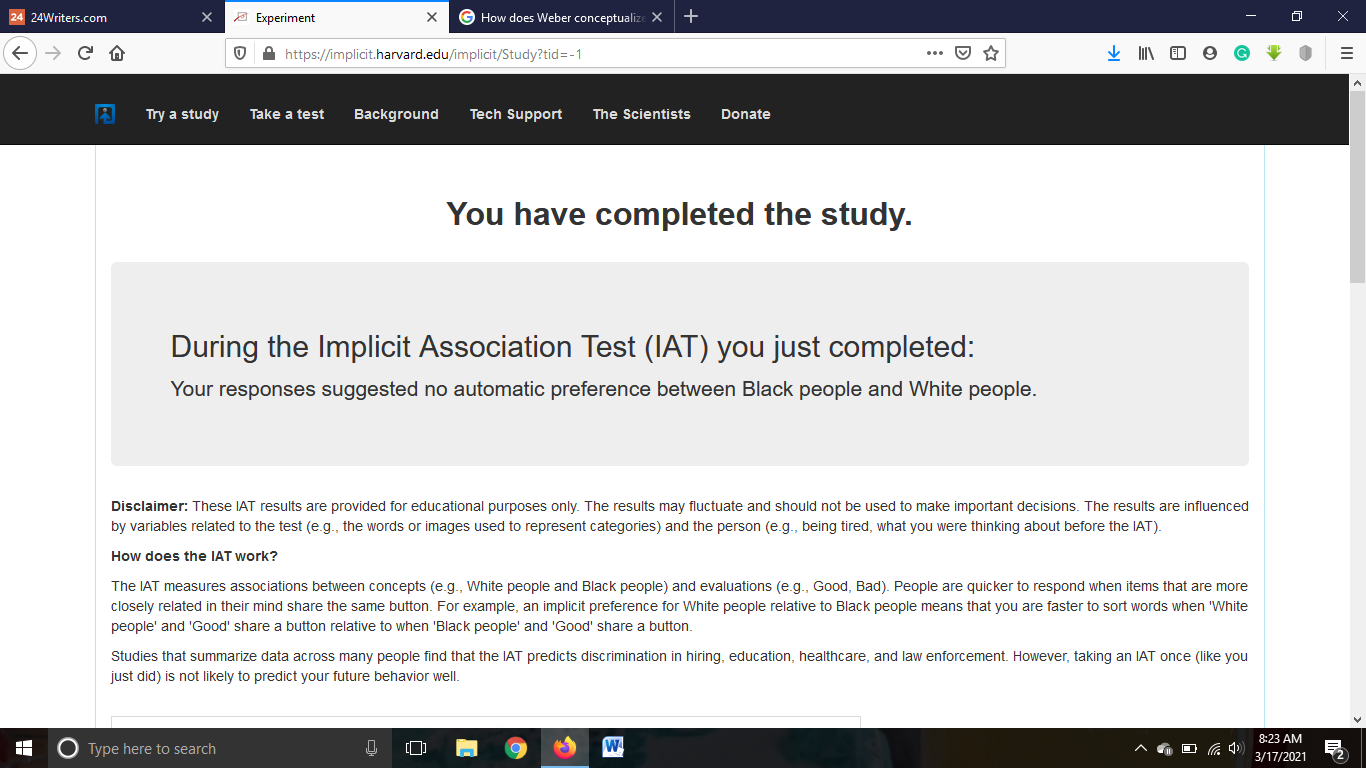Introduction
The Implicit Association Test (IAT) is trying to measure how strongly stereotypes or evaluations about race and other concepts are related. The test is structured so that the items with closely related evaluations share the same response key, which helps determine how the respondent feels about the concept. The result of the test is dependent on the length of time the respondent takes to sort the words “good” or “bad” and “black” or “white” based on the query. The test reveals the implicit preference that people do not even think they have. When a person responds faster to answer a given question about straight or good people, it implies that the respondent has an implicit reference to that category of people. While undertaking the test, a respondent unconsciously associates the black race with certain black stereotypes. Therefore, the test measures the implicit stereotypes that the test subjects hold regarding different races, even though they do not know they had those implicit biases.

From my Implicit Association Test (IAT) results, it was clear that I did not have any automatic preference between Black people and White people. Racial stereotypes are harmful, whether positive or negative, and they play a significant role in shaping attitudes toward certain races, which, in turn, promote racial discrimination. It is not fair to stereotype people based on race without considering individual differences instead of generalizing a racial group as having a uniform trait. Everyone needs to take a real commitment to overcome these stereotypes in order to create a harmonious society in which everyone is embraced and valued regardless of their race.
Sociologists’ Definition of Race and Ethnicity
Race and ethnicity sound somewhat similar terms, and, in most cases, people use these words interchangeably without considering the inherent differences between them. Sociologists define these two terms differently, which helps to bring out the apparent differences in meaning. According to sociologists, race refers to the socially significant physical differences between specific cultures and groups (Little, 2016). A race is best considered a biological category rather than a social construction. People belonging to the same race share such physical characteristics as stature, facial features, and skin color. Little (2016) argues that, in most cases, skin tone is used to differentiate different races since some people are dark-skinned while others are light-skinned. Nevertheless, sociologists view the concept of race as unstable since it keeps shifting depending on the prevailing social structures and forces, which makes it simply an illusion.
Some differences exist between racism, prejudice, and discrimination, although these terms sound somewhat similar in everyday conversation. Prejudice refers to attitudes, thoughts, and feelings motivated by oversimplified ideas about a given racial group based on a prejudgment outside actual experience (Little, 2016). On the other hand, discrimination refers to the actions towards certain groups of people based on one’s attitude towards them based on health, age, or religion. Lastly, racism is a form of discrimination that involves a set of attitudes and beliefs about a given racial group. It attempts to justify the idea that one race is inferior to the other. Institutional racism refers to a situation when the system allows for disenfranchisement of certain racial groups in a country’s education, judicial, state, and economic institutions, causing inequalities along racial lines (Little, 2016). On the other hand, individual discrimination comprises a person’s assumptions and behavior about a given racial group. The individual feels that he or she is superior to the other because of ethnic background or skin color.
On the other hand, sociologists define ethnicity as a shared culture that includes a group’s beliefs, values, practices, traditions, religion, and language. According to Little (2016), over time, just like race, the meaning of ethnicity has continued to change. People self-identify with particular ethnic groups in many complicated ways. For example, the whites can include the Jewish, Serbian, American Italian, and Irish. Ethnicity has become an identification method that people use in day-to-day relations, non-discrimination laws, and affirmative action initiatives.
Minority groups are the people who are singled out from the rest based on their physical appearance or cultural characteristics for unequal and differential treatment. Of this isolation, minority groups view themselves as objects of collective discrimination (Little, 2016). In contemporary society, the term minority connotes discrimination and can be used interchangeably with subordinate groups because they lack power compared to majority groups. In the U.S., assimilation has worked since the immigrants have integrated well into the American society, and all people are working together to strengthen the country’s culture and economy. Thus, the longer the immigrants live in the United States, the more they assimilate into the American culture (Little, 2016). Racial passing is a concept that refers to when a given racial group accepts a person who is classified to be a member of another racial group. The accepted individual disguises their race for a number of reasons, including individualistic motivations to enjoy the privileges enjoyed by the dominant race, such as tuition fee waiver and consideration for a scholarship.
Reference
Little, W. (2016). Introduction to sociology, 2nd Canadian edition. BCcampus.